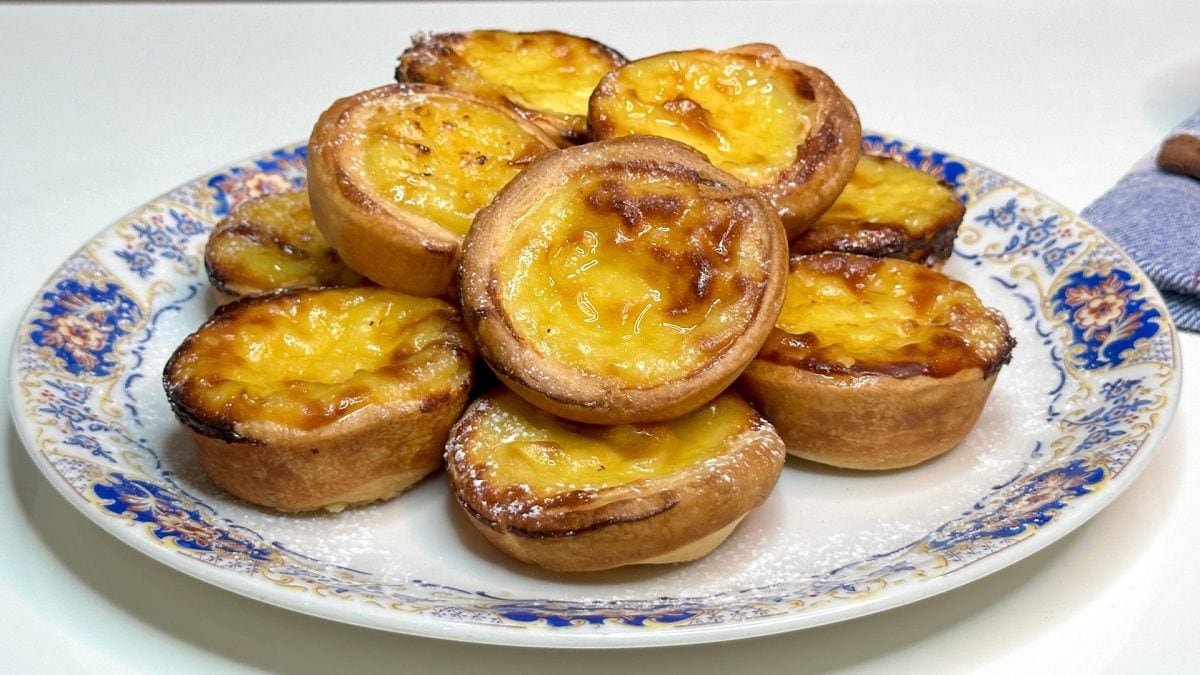
These Portuguese Custard Tarts, known as Pastéis de Nata, are a world-famous Lisbon specialty. With their flaky puff pastry shells, silky custard filling, and signature caramelized tops, they’re the perfect combination of crisp, creamy, and sweet. Best served warm with a dusting of cinnamon or powdered sugar, they’re an irresistible treat for breakfast, dessert, or coffee time.
What Are Pastéis de Nata?
Pastéis de Nata (pronounced pahs-TAYSH deh NAH-tah) are iconic Portuguese custard tarts originating from the 18th century at the Jerónimos Monastery in Lisbon. Created by monks to use up surplus egg yolks, they became a bakery staple throughout Portugal and beyond. These tarts are known for their crackly top, creamy custard, and delicate, flaky crust—often served warm with cinnamon and powdered sugar.
Why Everyone Will Love This Recipe
- Incredible Flavor: Buttery, crisp pastry meets a smooth, cinnamon-kissed custard.
- Easy to Make at Home: No need for fancy tools or professional molds.
- Crowd-Pleaser: Serve these at a party, and they’ll disappear in minutes.
- Classic with a Twist: Add your own flair with orange zest or nutmeg.
- Perfect Anytime: Great for holidays, brunch spreads, or with coffee.
Pro Tips for the Best Pastéis de Nata
- Use cold puff pastry to get the flakiest crust—don’t skip the chilling step.
- Don’t overbake the custard—look for dark spots on top, not a firm center.
- Use a cinnamon stick, not ground cinnamon, for a clearer, smoother syrup.
- Wet your fingers when shaping the pastry—this helps it spread evenly without tearing.
- Bake at high heat to achieve the signature caramelized top.
Frequently Asked Questions
Can I Use Store-Bought Puff Pastry?
Absolutely. Store-bought rectangular puff pastry works great—just make sure it’s thawed but still cold before rolling.
Why Did My Custard Curdle?
The custard can curdle if it’s overheated. Be sure to remove it from the heat once it starts to thicken slightly and stir constantly.
How Do I Know When the Tarts Are Done?
The tops should be dark golden with some caramelized spots. The custard should still have a slight jiggle.
Can I Make Pastéis de Nata Ahead of Time?
Yes! You can make the cream and shape the pastry cups ahead of time. Assemble and bake when ready to serve.
Do I Need Special Molds?
No. You can use muffin tins or short aluminum molds—just grease them well with butter.
Can I Make These Without Eggs?
Unfortunately, eggs are essential for the custard’s texture and flavor in this traditional recipe.
How to Store Pastéis de Nata
Let the tarts cool completely, then store them in an airtight container in the refrigerator for up to 3 days. For the best texture, reheat them in a 350°F (175°C) oven for 5–7 minutes to crisp up the pastry again.
How to Freeze Pastéis de Nata
To freeze after baking, allow them to cool, then wrap each tart in plastic wrap and foil. Freeze for up to 2 months. Reheat directly from frozen in a hot oven for 10–12 minutes.
Freezing before baking is not recommended, as the custard texture may not hold up well once thawed.
How To Make Pastéis de Nata
Prepare the Pastry:
Roll out the puff pastry and roll it tightly from the short end to form a log. Wrap in plastic wrap and refrigerate for 20 minutes.
Prep the Molds:
Butter your muffin or aluminum molds. Slice the chilled pastry log into 15–20 rounds.
Shape the Tart Shells:
Place a slice of dough in each mold, spiral side up. Wet your fingers and press the dough from the center outward, pushing it up the sides to form a cup.
Make the Syrup:
In a small saucepan, combine water, sugar, lemon zest, and cinnamon stick. Bring to a boil and simmer for 2 minutes. Strain and set aside.
Make the Custard Base:
In a separate pot, whisk together flour, cornstarch, and salt. Gradually add milk while whisking to prevent lumps. Cook on low heat until slightly thickened.
Combine Cream and Syrup:
Remove the thickened milk mixture from the heat. Gradually pour in the syrup in 3–4 parts, stirring after each addition.
Add Eggs:
Once the mixture is lukewarm, whisk in the egg yolks and whole eggs until smooth.
Fill the Shells:
Pour the custard into the pastry cups, filling about ¾ of the way.
Bake:
Preheat a convection oven to 250°C (482°F). Bake for 25 minutes on the middle rack. If needed, move to the top rack and use the broiler for 5 minutes to brown the tops.
Glaze and Serve:
Optional: Mix hot water with sugar and brush over the warm tarts for shine. Sprinkle with cinnamon or powdered sugar just before serving.

;Resize,width=767;)
